CYCLINGTIPS.COM: Thule UpRide vs Yakima HighRoad bike rack comparison review
This review and photography of the Yakima HighRoad upright bike mount by David Rome was originally published at cyclingtips.com on September 25, 2018.
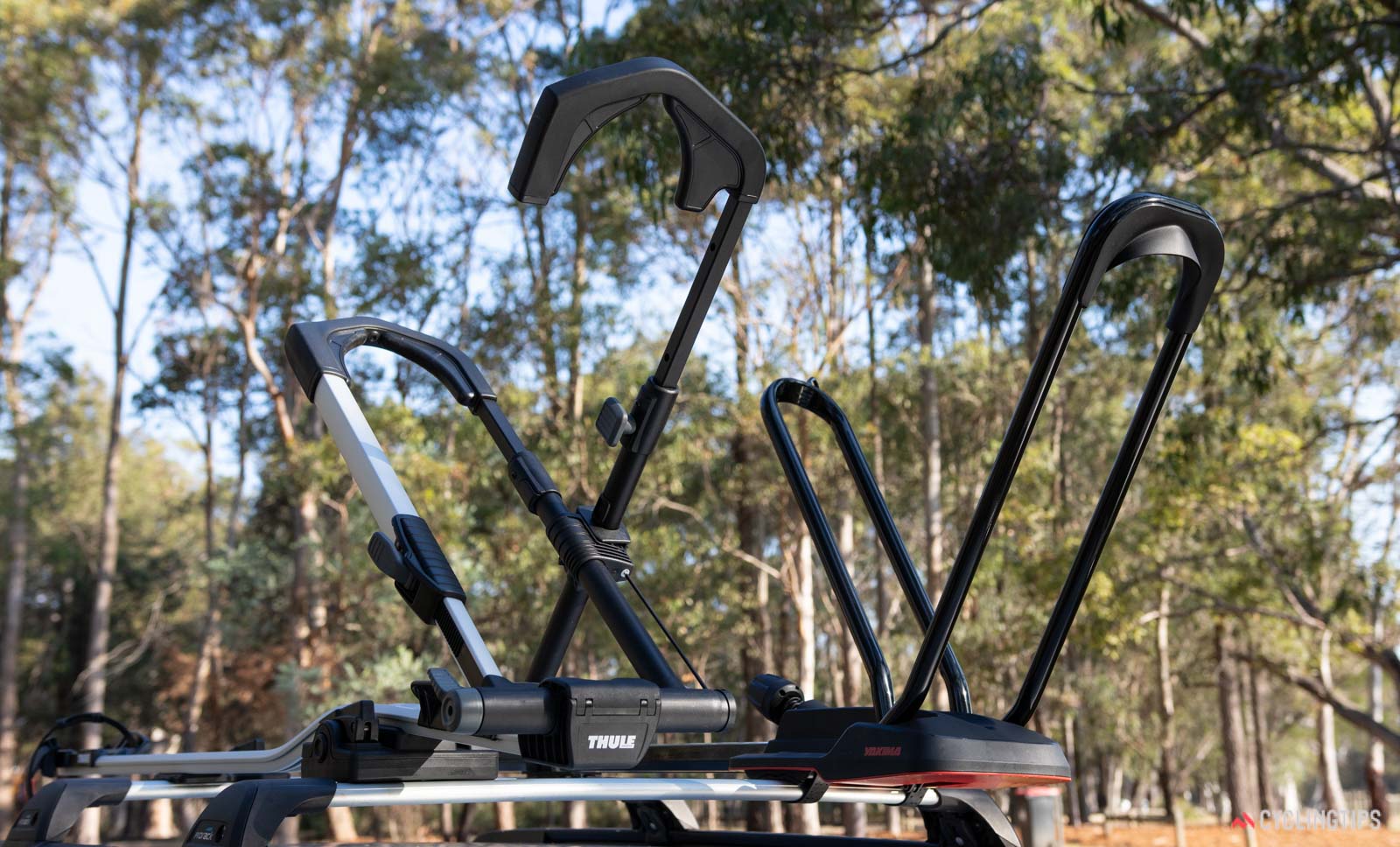 Yakima HighRoad versus Thule UpRide bike carrier review
Yakima HighRoad versus Thule UpRide bike carrier reviewAs bike preferences have grown more diverse, and automobiles have grown ever bigger and taller, the once-common roof-based bike carriers have steadily lost ground to rear-mounted racks that are not only easier to load, but usually don’t require you to remove the front wheel, either.
That said, roof racks are still preferred by many riders, and the latest generation of carriers that contact only your bikes’ wheels do a much better job of securing your precious cargo, regardless of dropout type, frame material, cable routing, or even ill-placed bidon cages.
Yakima was first with such an idea, and now Thule has joined the party. Tech writer Dave Rome has had plenty of experience with both brands, and here he compares the new Thule UpRide 599 against the Yakima HighRoad Upright Bike Mount.
HOW THEY WORK
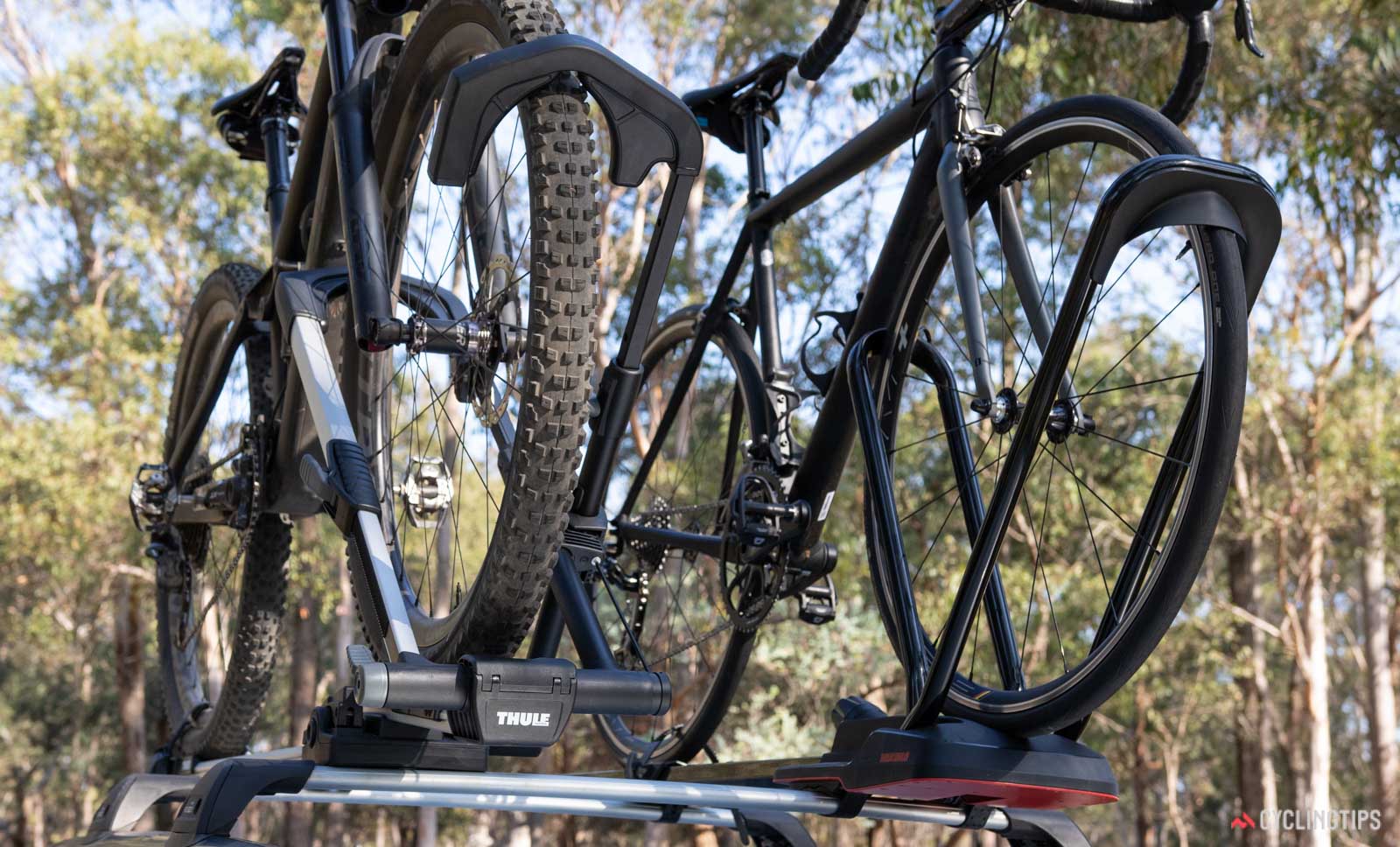 Both of these racks hold the bike upright by the front wheel.
Both of these racks hold the bike upright by the front wheel.If you lock the front wheel in an upright and straight plane, the rest of the bike will stay upright, too. Both of these racks work on this concept, and both create a secure and rigid hold that clamps the front wheel firmly in place.
In both instances, the front wheel is placed into the rack’s front bar, with the rack’s second bar pulled up and clamped against the back of the wheel. The rear wheel is then strapped into a regular wheel tray, and away you go.
However, Yakima and Thule each go about that front wheel clamping in totally different ways, and as this review will detail, the Yakima HighRoad does it better.
ASSEMBLY AND FITTING
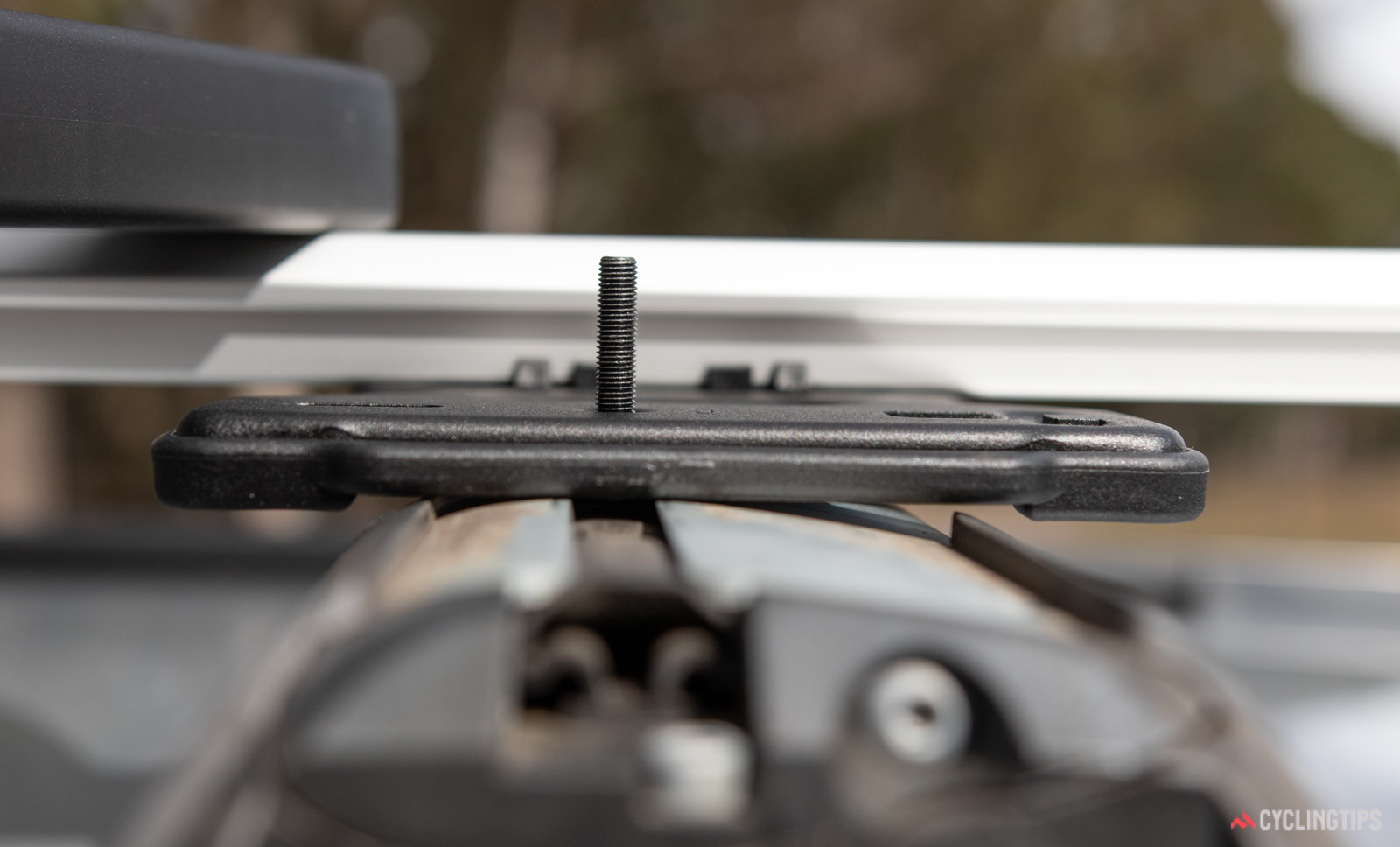 The Thule UpRide comes with T-Track bolts to work with a variety of premium crossbars.
The Thule UpRide comes with T-Track bolts to work with a variety of premium crossbars.The Thule UpRide comes out of its box mostly assembled, and includes T-Track hardware to work with newer crossbars from the likes of Thule, Prorack, and many others. Conversion kits are available if you have older rectangular or round crossbars, or any variety of factory crossbars that don’t incorporate the increasingly popular T-track channels.
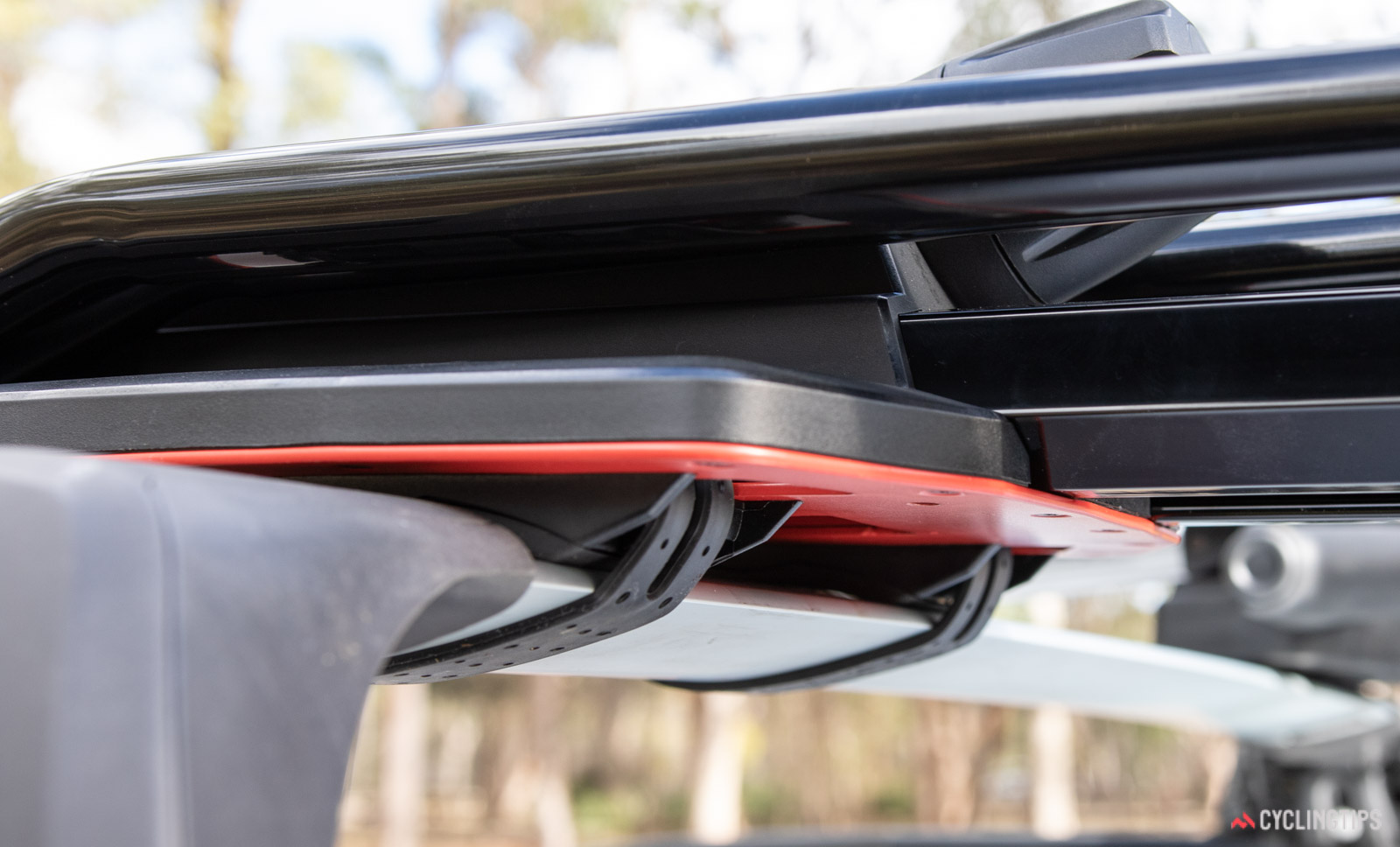 The Yakima comes with a more flexible strap method for mounting.
The Yakima comes with a more flexible strap method for mounting.The Yakima comes out of the box fully assembled, and uses an adjustable rubber-coated stainless steel strap system that attaches to virtually any crossbar shape. Sold separately, a conversion kit allows direct attachment to T-track crossbars for a slightly cleaner look.
Both racks can be configured for either driver or passenger-side mounting. The Yakima is by far the simplest in this regard, with the only difference being how the rear wheel strap is hooked in. In contrast, the Thule requires you to reconfigure a few parts via an easy-to-follow, IKEA-like picture manual (hey, it’s a Swedish company and they even include an Allen key!)
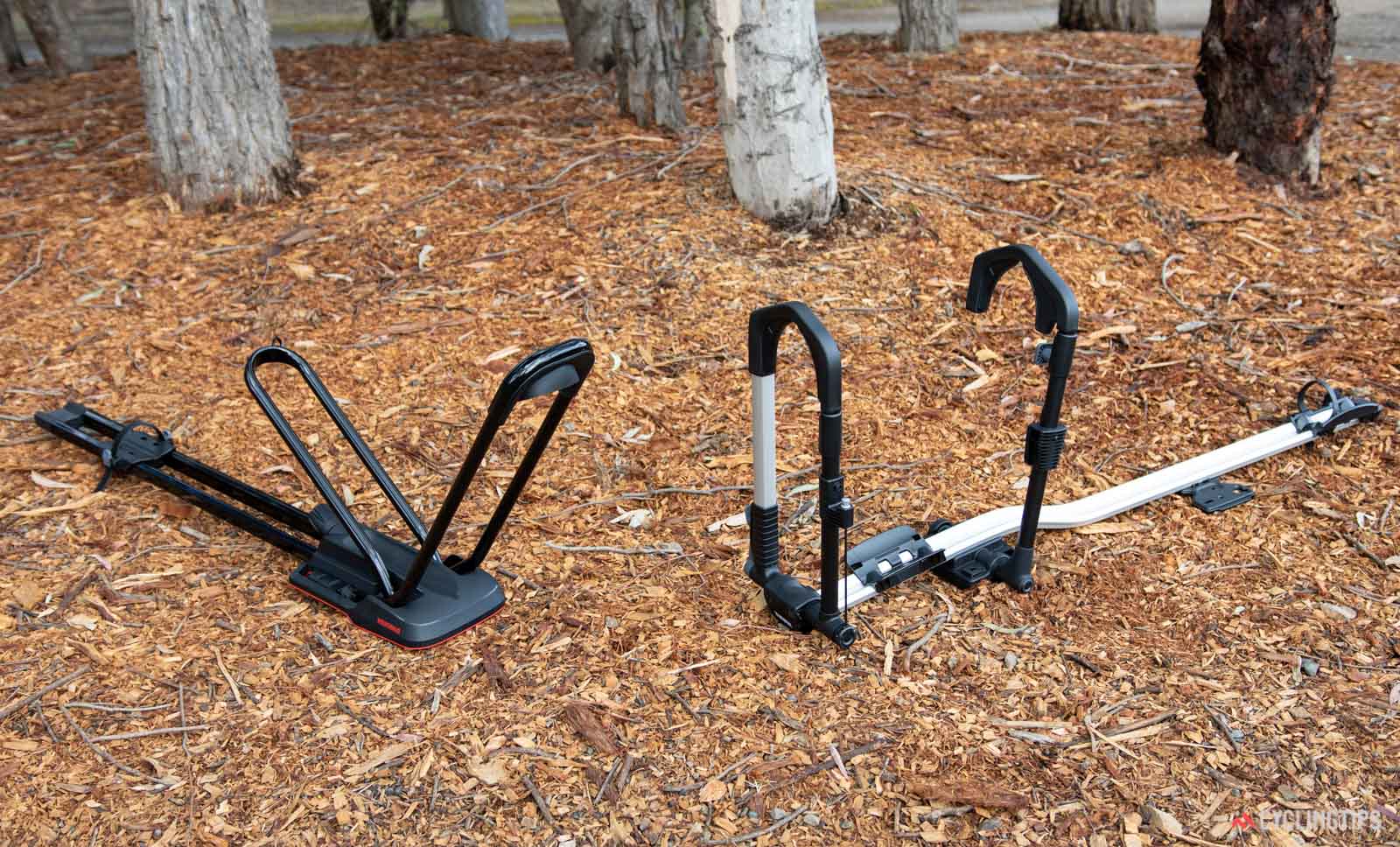 From a mounted length perspective, the racks are quite similar.
From a mounted length perspective, the racks are quite similar.Total folded length of the Yakima HighRoad is 140cm, while the Thule UpRide measures in at a longer 164cm. Weight-wise, the Thule is marginally lighter at 7.85kg to Yakima’s 8.27kg figure. Both feature a rear wheel tray that slides free of the mounting mechanism, meaning you don’t need to worry about how your crossbar spacing will impact bike compatibility.
Both Thule’s T-Track and Yakima’s strap system work admirably well and are fast to fit, but I’m going to give the first point to Yakima due to its easier and wider universal compatibility straight from the box.
SECURITY
Both racks can be locked to the crossbar, and both also feature integrated cable locks that tuck neatly into the tray when not in use. The 8mm-thick cable on the Yakima seems more difficult to cut than the one on the Thule, but in both cases, the cable is only long enough to
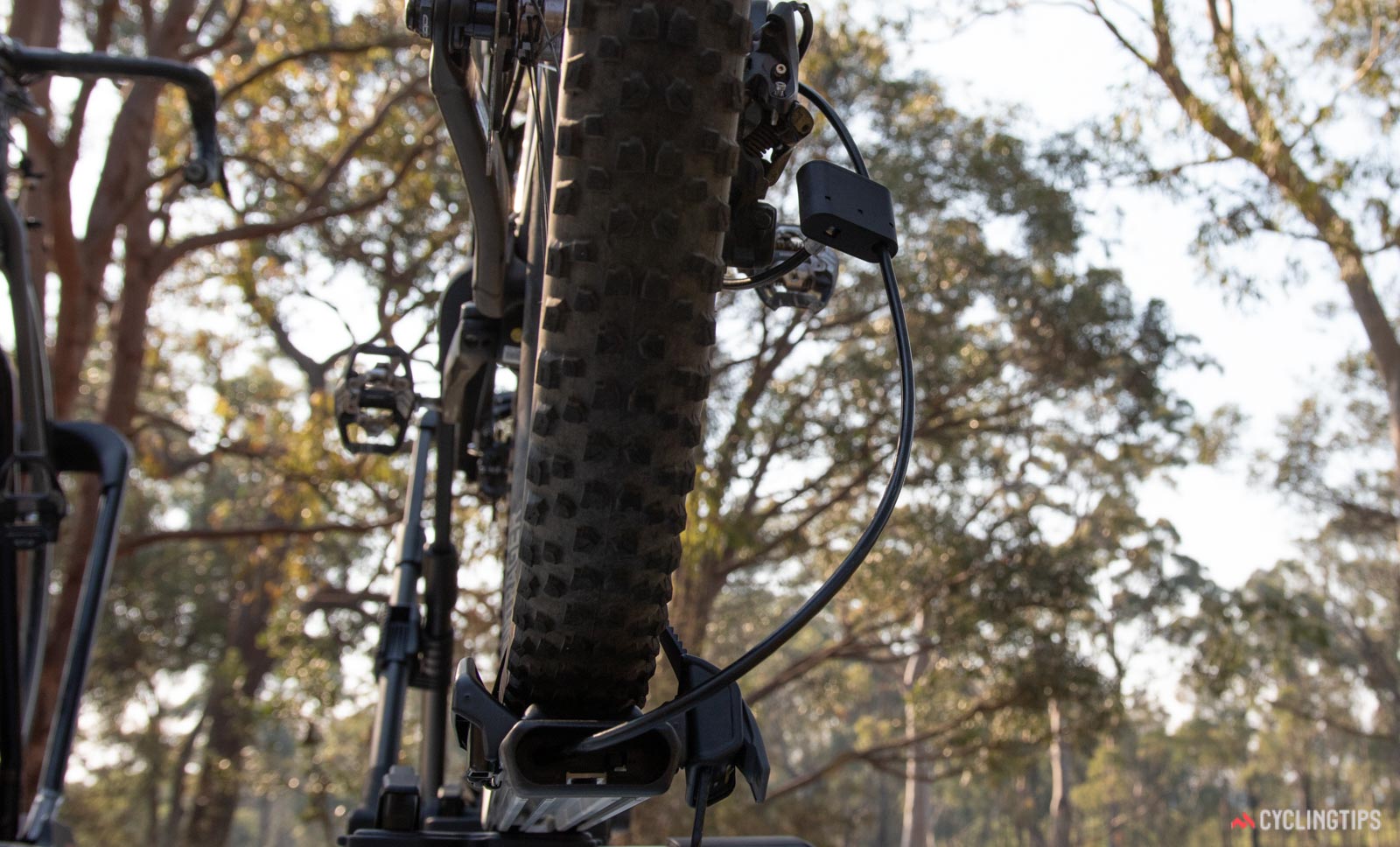 Both racks feature integrated cable locks.
Both racks feature integrated cable locks.reach through the rear triangle and the rear wheel. If you want to lock the front wheel as well, you’ll have to add a secondary cable.
Thule includes two lock cores with its AU$369 UpRide rack: one to secure the T-track adjustment handle in place, the other for the cable lock.
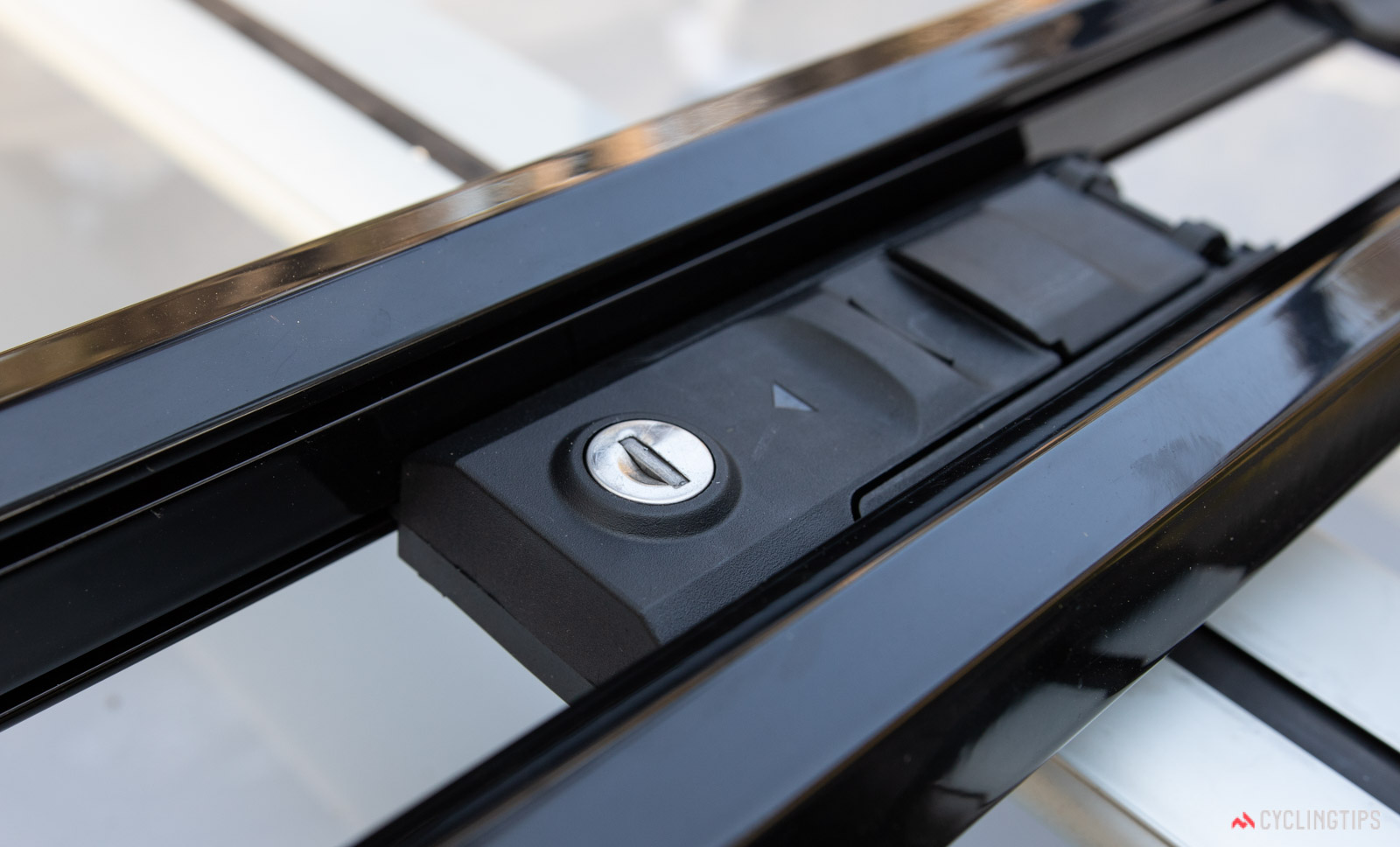 The Yakima can also be locked to a car’s crossbars.
The Yakima can also be locked to a car’s crossbars.By comparison, the Yakima HighRoad is slightly less expensive at AU$349, but that price doesn’t include lock cores. Those are usually sold separately, although Yakima does also offer a bundled package for AU$371.
Both companies allow you to order lock cores to match your other similarly branded rack accessories, so you won’t have to keep adding keys.
Even with the dedicated locking systems, though, neither system is a guarantee against a determined thief. Yakima’s rubber-coated steel straps can be cut, for example, and it’d be just as easy to saw through the Thule’s locked handle. Always think of the locks on bike racks as a deterrent. If only because the locks are provided with the UpRide, Thule gets the first point here.
LOADING BIKES
Loading bikes on either of these carriers is far simpler than trying to line up a clamp with the bike’s down tube — as required by many older roof-mounted carriers — but the Yakima is in a league of its own for ease of use. You first raise the forward loop, then slide the bike’s front wheel into it, at which point the bike is already held fairly steady. From there, you pull up the rear hoop – taking care that the crankarms aren’t in the way – and spin the threaded knob to lock the front wheel in place.
The knob also has a convenient torque-limiting feature — not unlike many torque wrenches — and you simply tighten it until it clicks. It removes any guesswork over whether the bike is secure or not, but it does require a firm grip.
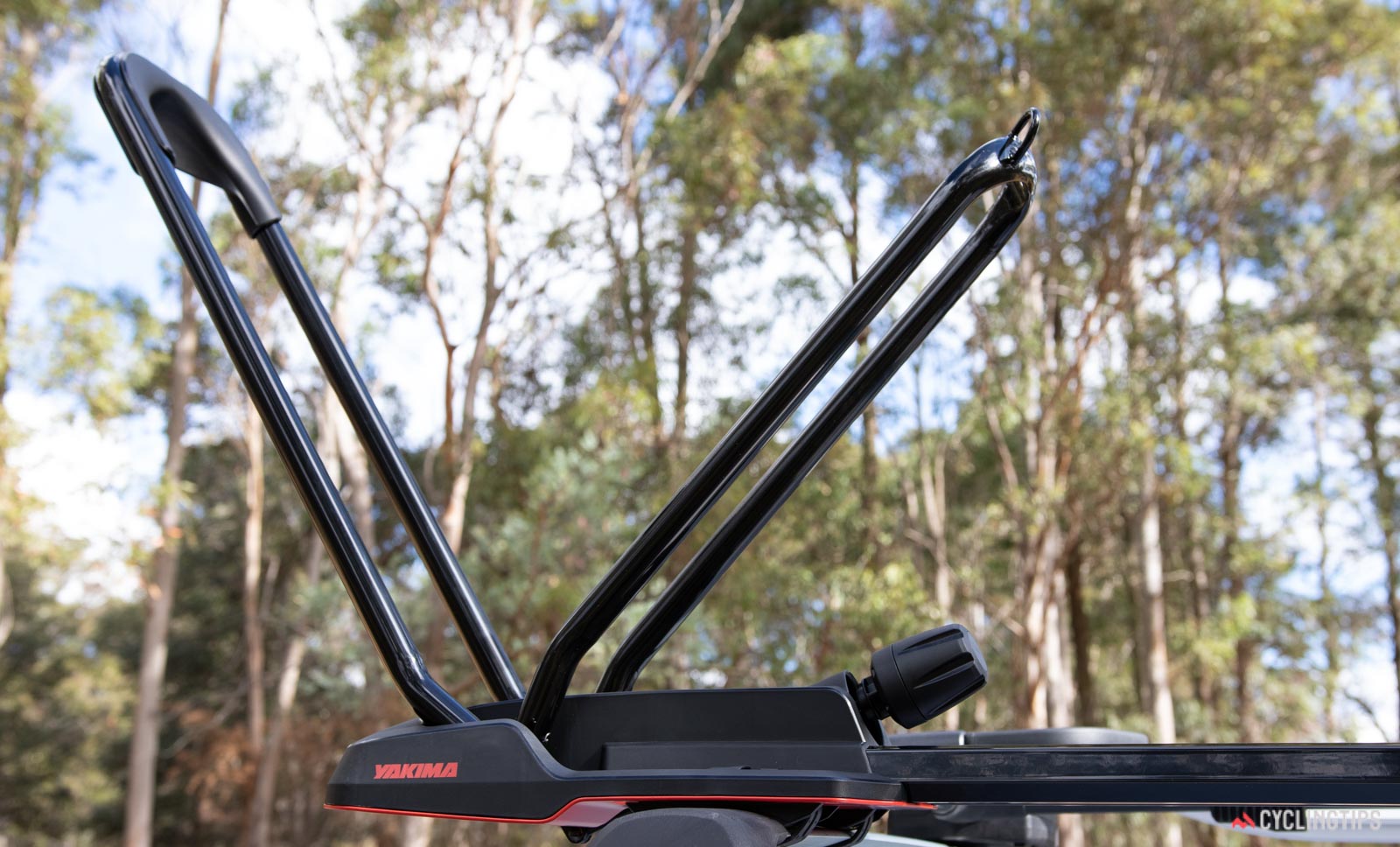 The Yakima’s design looks more rudimentary, but is actually easier to use.
The Yakima’s design looks more rudimentary, but is actually easier to use.Earlier generations of Yakima upright carriers required you to first set your wheel size with an adjustable front hoop, but the simpler HighRoad doesn’t require this. The trade-off is that where older versions would let you carry anything from a 20in to 29in-wheeled bike, the HighRoad will only work with 26in wheels and up. Yakima states the HighRoad will work with any tyre width between 23mm to 3.25in (83mm). In my case, the rack comfortably handled road bikes, gravel bikes, and a 29er trail mountain bike.
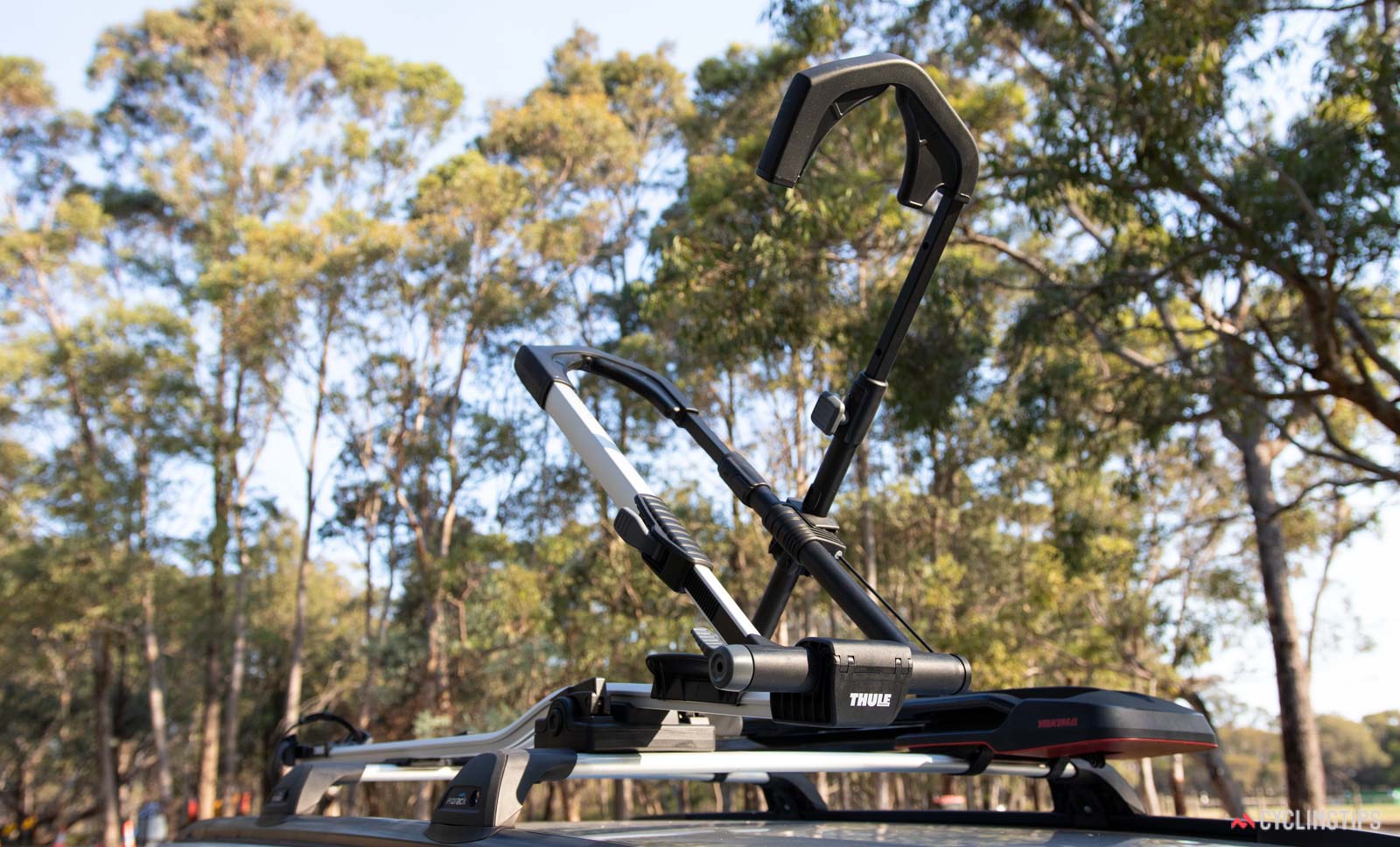 Thule’s design uses two independent arms that intersect and connect with each other.
Thule’s design uses two independent arms that intersect and connect with each other.The Thule retains that wider range of wheel size compatibility, fitting wheel sizes from 20-29in. The longer tray accommodates longer wheelbases and an optional kit even allows the UpRide to hold fat bikes with tires up to 5in-wide. But it still has more moving parts and is more cumbersome to use, and unless you’re carrying something really unusual, the Yakima’s shorter length is already more than enough even for super-slack enduro rigs.
The UpRide’s front wheel hook features a number of stepped positions, with a small window to show you the wheel size setting. Before you put the bike on the roof, this must be adjusted to fit the wheel size and is done by simply pulling on the spring-loaded knob and sliding the hook until it clicks into the right length.
If you only ever carry the one bike or style of bike, then this is something you can set and forget, although do be warned that when not in use, the front bar only folds fully flat when the forward loop is adjusted in one of the smallest wheel settings.
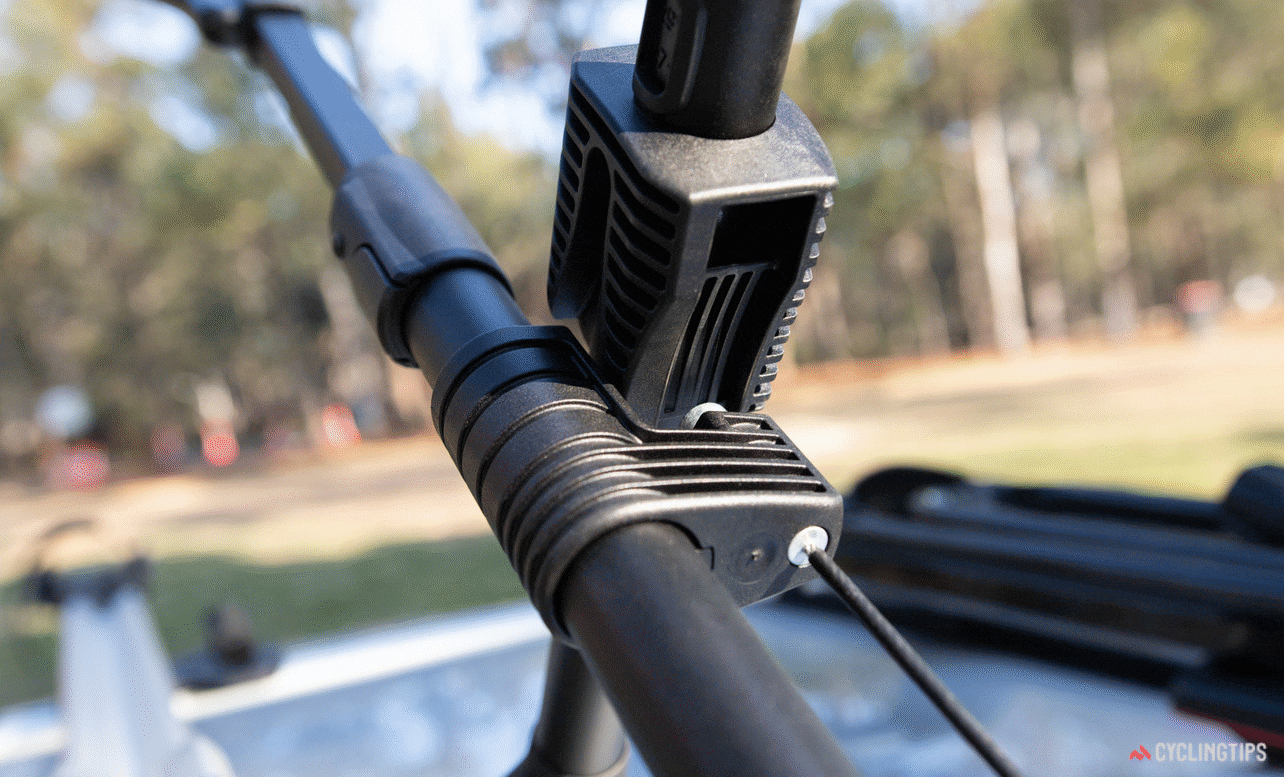 The two arms on the Thule UpRide must be connected together before final tightening.
The two arms on the Thule UpRide must be connected together before final tightening.The process to load bikes on to the Thule carrier is similar to that of the Yakima for the most part: load the bike’s front wheel into the front loop, and then pull the rear bar up. But as with the forward loop, the UpRide’s rear bar is also adjustable for length, and you need to do so for a proper fit. Complicating matters is the fact that both bars need to join in the middle to form an X-like structure, and if you get the lengths wrong, the connection points won’t meet up properly.
Once the forward and rearward arms are joined, you then tighten a plastic ratcheting lever (similar to what’s found on many cycling shoes) to tighten the bar down onto the front wheel, locking the bike in place.
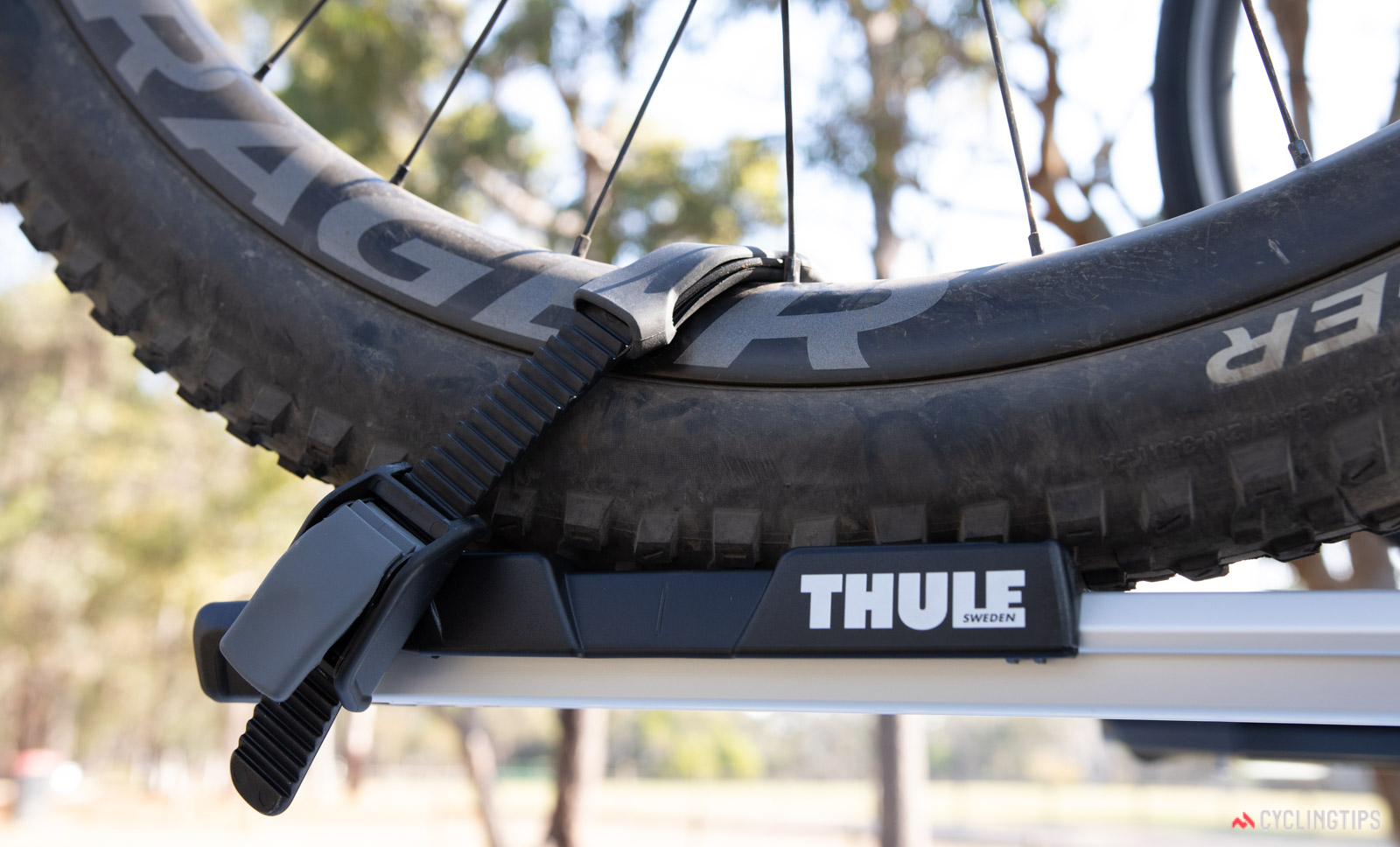 Thule’s rear wheel tray uses a diagonal strap that works better than Yakima’s simpler left-to-right strap configuration.
Thule’s rear wheel tray uses a diagonal strap that works better than Yakima’s simpler left-to-right strap configuration.Once the bikes are locked into the front part of the racks, the rear wheel is secured in place. The Yakima features a simple straight ratchet strap, which can be configured for left or right use. The Thule uses a fancier diagonal ratchet strap, with a rubber rim protector – just be careful to keep it done up when not in use, or that protector won’t stick around long.
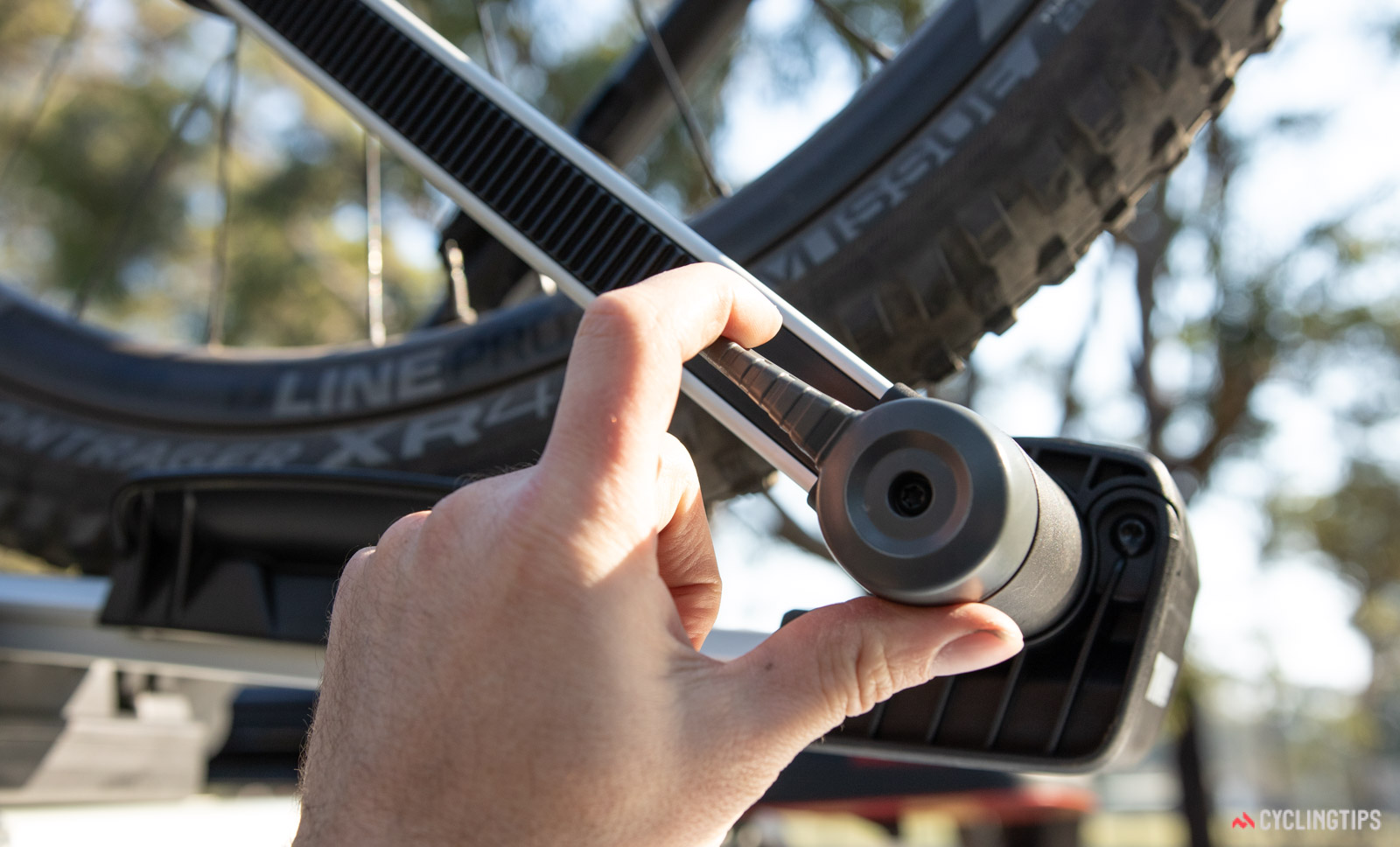 The Thule has a safety lock. Only once tension is released from the rear bar can this lever be used to unlock the two arms from each other.
The Thule has a safety lock. Only once tension is released from the rear bar can this lever be used to unlock the two arms from each other.Removing the bikes is an easier process in both cases. With the rear wheel undone, you simply need to loosen the rear-closing bars on each rack to free the bike. The Yakima is the simplest: just loosen the knob all the way and pull the bar down. For Thule, you loosen the ratchet mechanism of the rear bar, and then pull down on a small lever at the base of the rack to release the “X” locking mechanism. From here, the rear bar is free to release.
The Thule system works and is pretty quick to use once learned. However, it also features a little too much plastic for my liking. Both the “X” locking mechanism and the rear bar ratchet are made of fiber-reinforced plastic, and while Thule has proven itself time and time again to make reliable products (backed by a five-year warranty), I’d still prefer to see more aluminium used in these wear points.
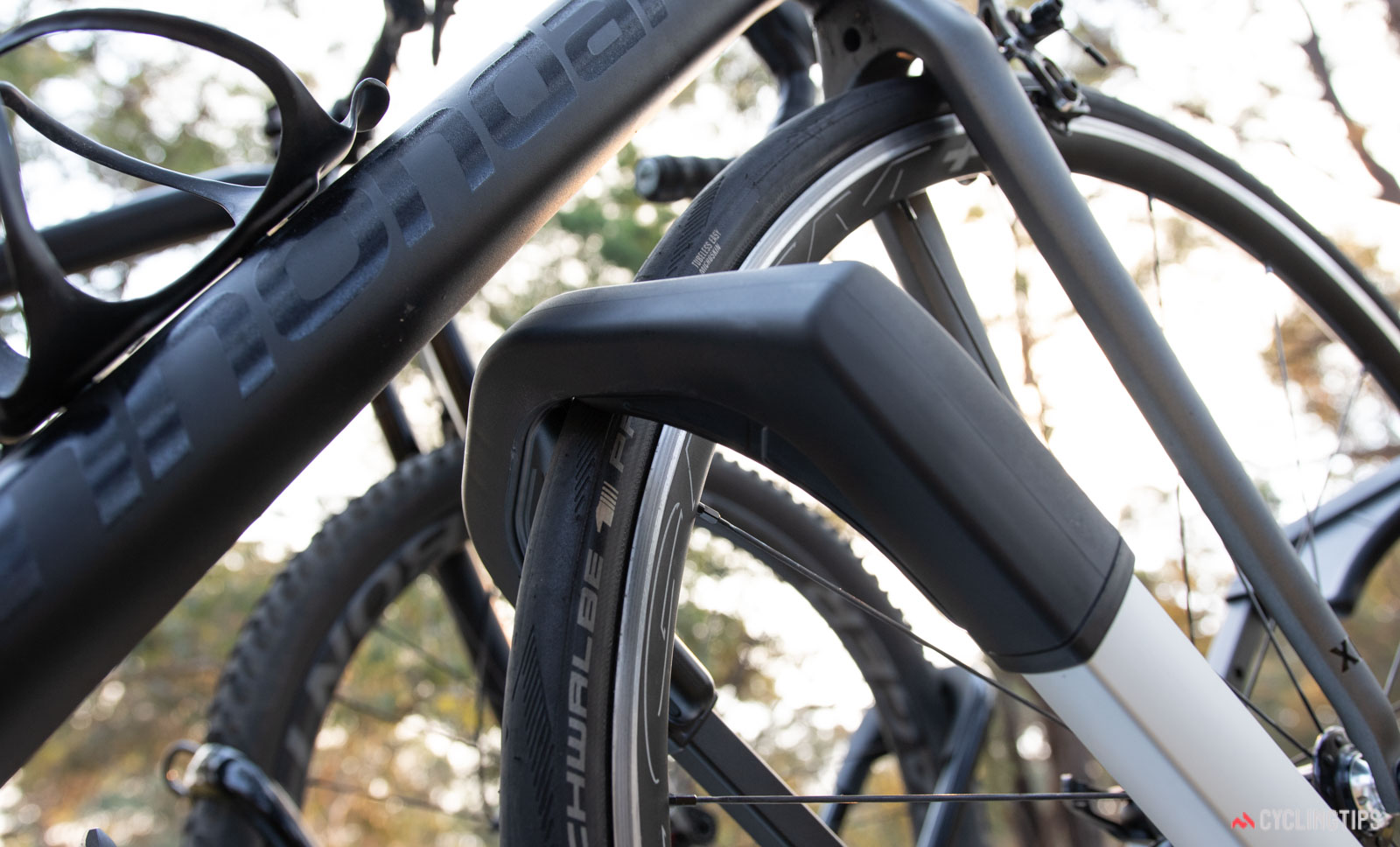 The Thule’s rear bar is more cumbersome than Yakima’s.
The Thule’s rear bar is more cumbersome than Yakima’s.It’s worth noting that the Thule’s rear bar is quite thick and may present fitment issues on frames that have the front wheel tucked closely beneath the down tube. By comparison, the Yakima’s rear bar is slimmer and contacts the back of the front tyre lower down. Neither rack will work on a bike fitted with full-length fenders.
Thule’s rear wheel tray is better, but Yakima has the clear edge in simplistic design. Unless you need to carry kids’ bikes with smaller wheels, Yakima gets the point here.
THE DRIVE
From my point of view, if the rack goes unnoticed when driving with or without a bike attached, it does its job. And in this case, both the Thule and Yakima succeed in not making any distracting noises.
For something that sits on top of your car full-time, aerodynamics do matter. But unfortunately, without access to a wind tunnel, I was unable to see which rack is more fuel efficient and so can only make some educated guesses based on the frontal profile when not holding a bike.
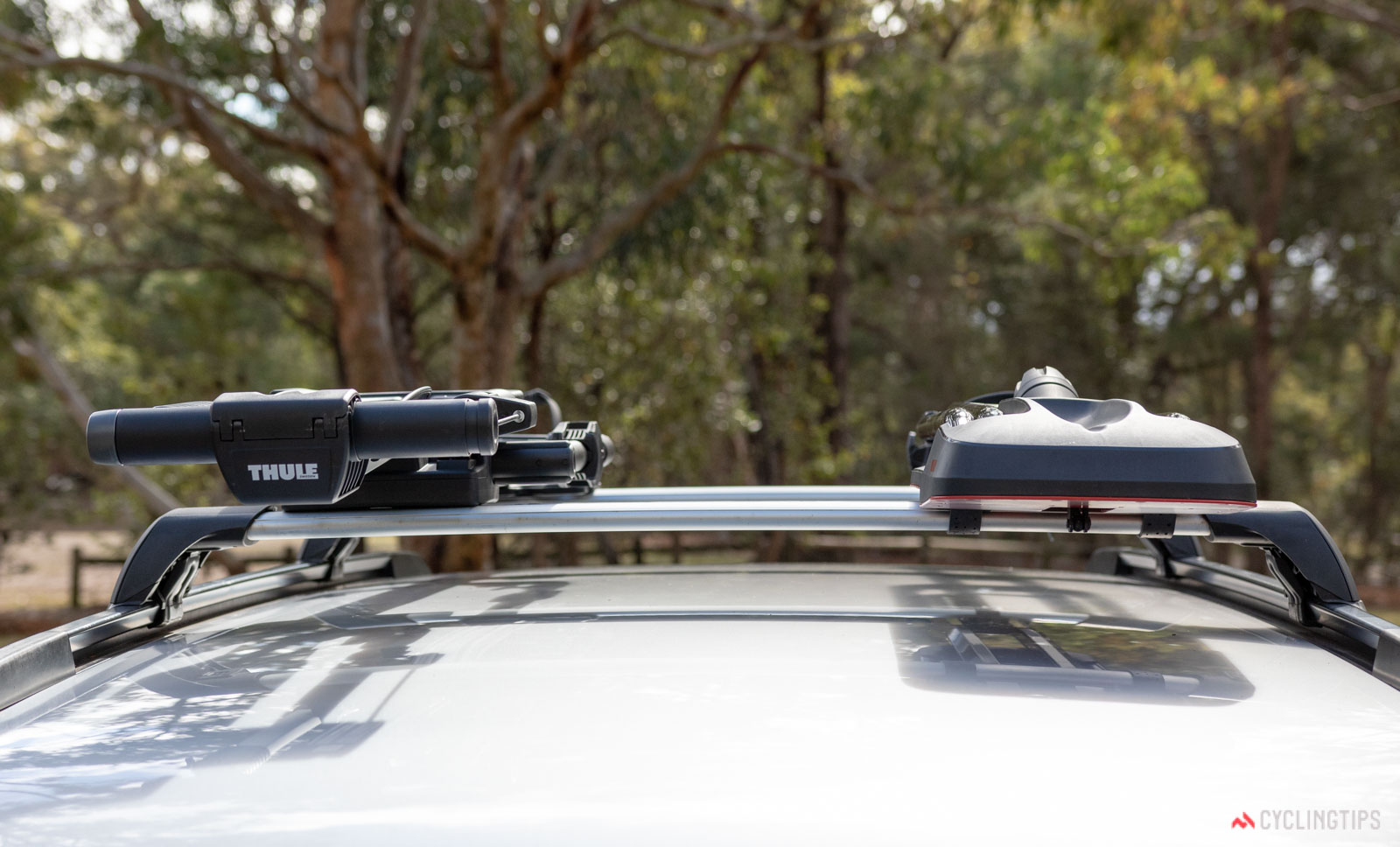 Without a bike, the Yakima (right) clearly has a narrower frontal profile.
Without a bike, the Yakima (right) clearly has a narrower frontal profile.Nevertheless, Yakima seems to have the advantage here. It has a smoother surface beneath it and a more streamlined shape above. In contrast, the Thule greets the wind with a big fat cylindrical tube – a known aero no-no. This dubious point goes to Yakima.
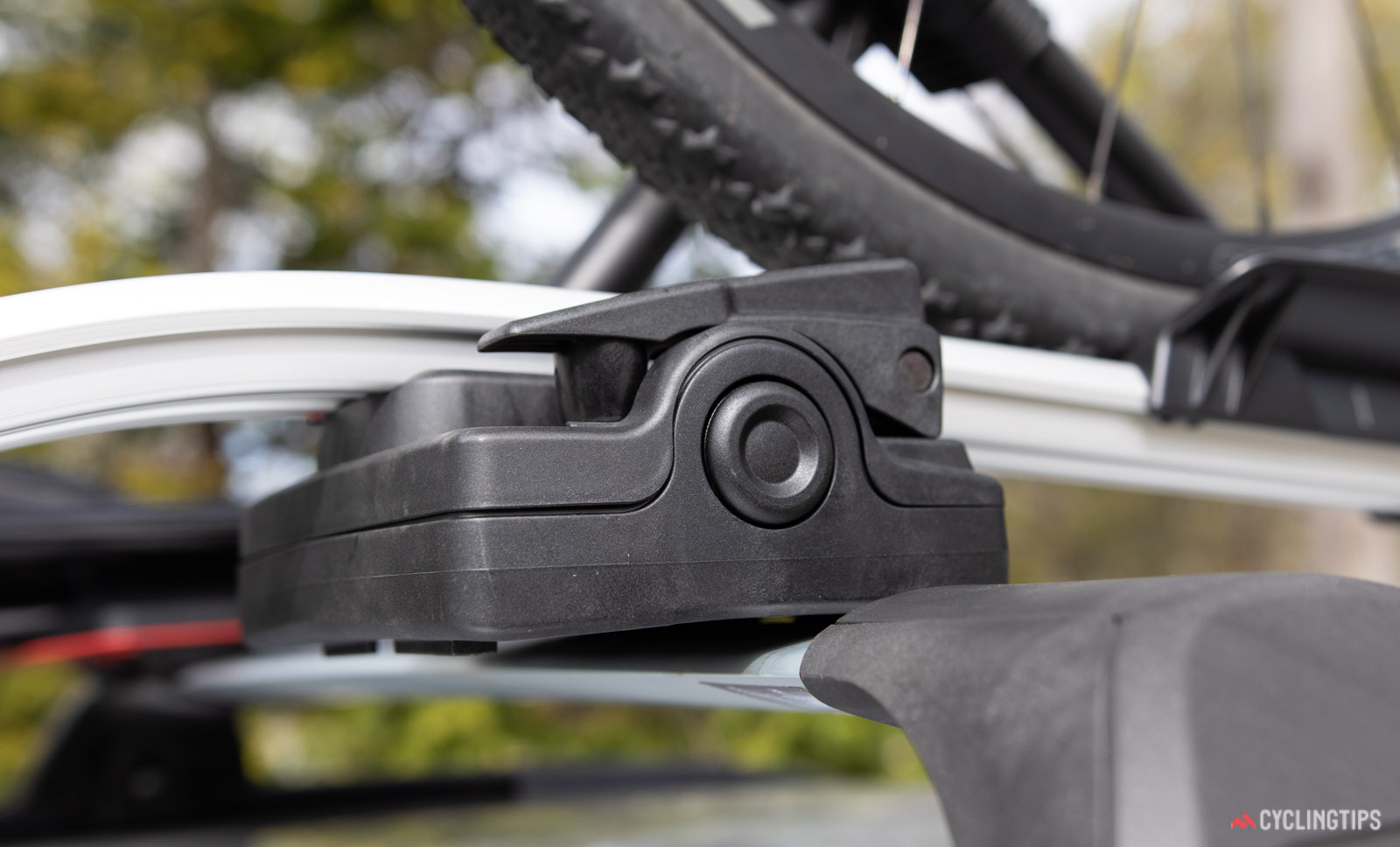 The plastic base on the Thule UpRide noticeably flexes if you shake the mount side-to-side.
The plastic base on the Thule UpRide noticeably flexes if you shake the mount side-to-side.In terms of their hold strength, both racks grip the front wheel in a way you needn’t worry about. However, the Yakima feels more secure and wobbles less, something that is most noticeable with a heavier mountain bike. If you rock a bike left and right in the Thule rack there’s visible flex in the plastic base, especially around the rear bar’s connection point. It wasn’t bad enough that I was concerned about the safety of a bike (or drivers behind me), but that sort flex can only lead to long-term material fatigue, and so earlier worries of durability once again arise.
Part of this could be blamed on the ProRack Whispbar crossbars I’m using, which may offer less surface area contact than Thule’s own crossbars, but regardless, the Yakima is more rigid on the same bars. Point, Yakima.
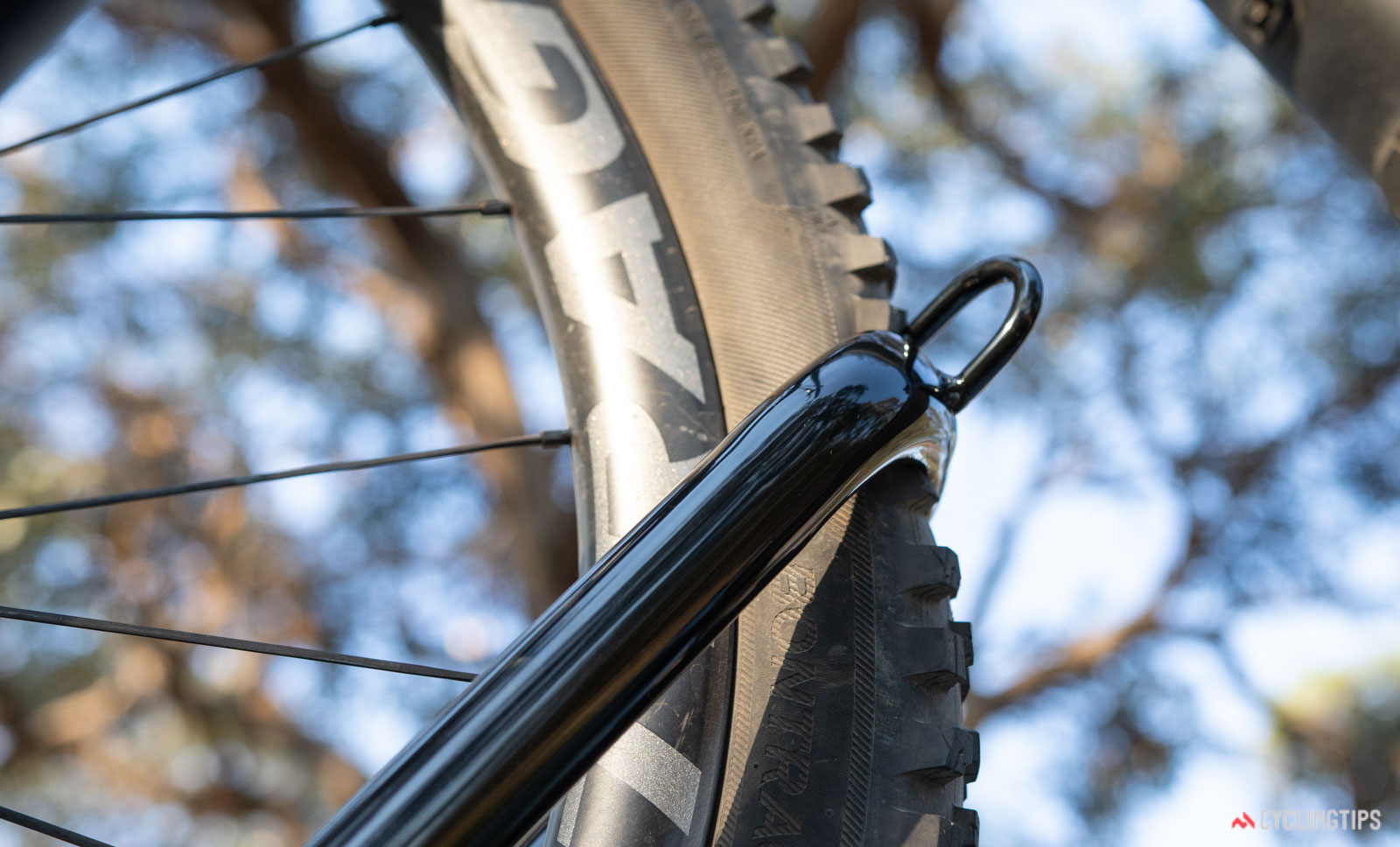 Low tyre pressures aren’t such an issue, as the racks will create the necessary pressure. However, a flat tyre is still a no-no for this style of rack.
Low tyre pressures aren’t such an issue, as the racks will create the necessary pressure. However, a flat tyre is still a no-no for this style of rack.It should be mentioned that one big warning for this type of rack is that it relies on some front tyre pressure to work properly. Granted, even a tyre that gradually goes completely flat after the bike is mounted isn’t likely to fall out of the carrier entirely, but it’s still something to keep in mind.
THULE OR YAKIMA, WHAT TO BUY?
It’s pretty clear that Yakima stole the show with this one. Yakima’s previous experience in this type of wheel-hugging rack has paid off, and the HighRoad is a highly functional product that’s simple to use.
Thule has a well-deserved reputation for making market-leading racks with impressive attention to detail, and while the UpRide does many things right, it just doesn’t reach my high expectations of the Swedish company. If you like this style of roof-mounted bike carrier and just want to carry adult-sized bikes, buy the Yakima.
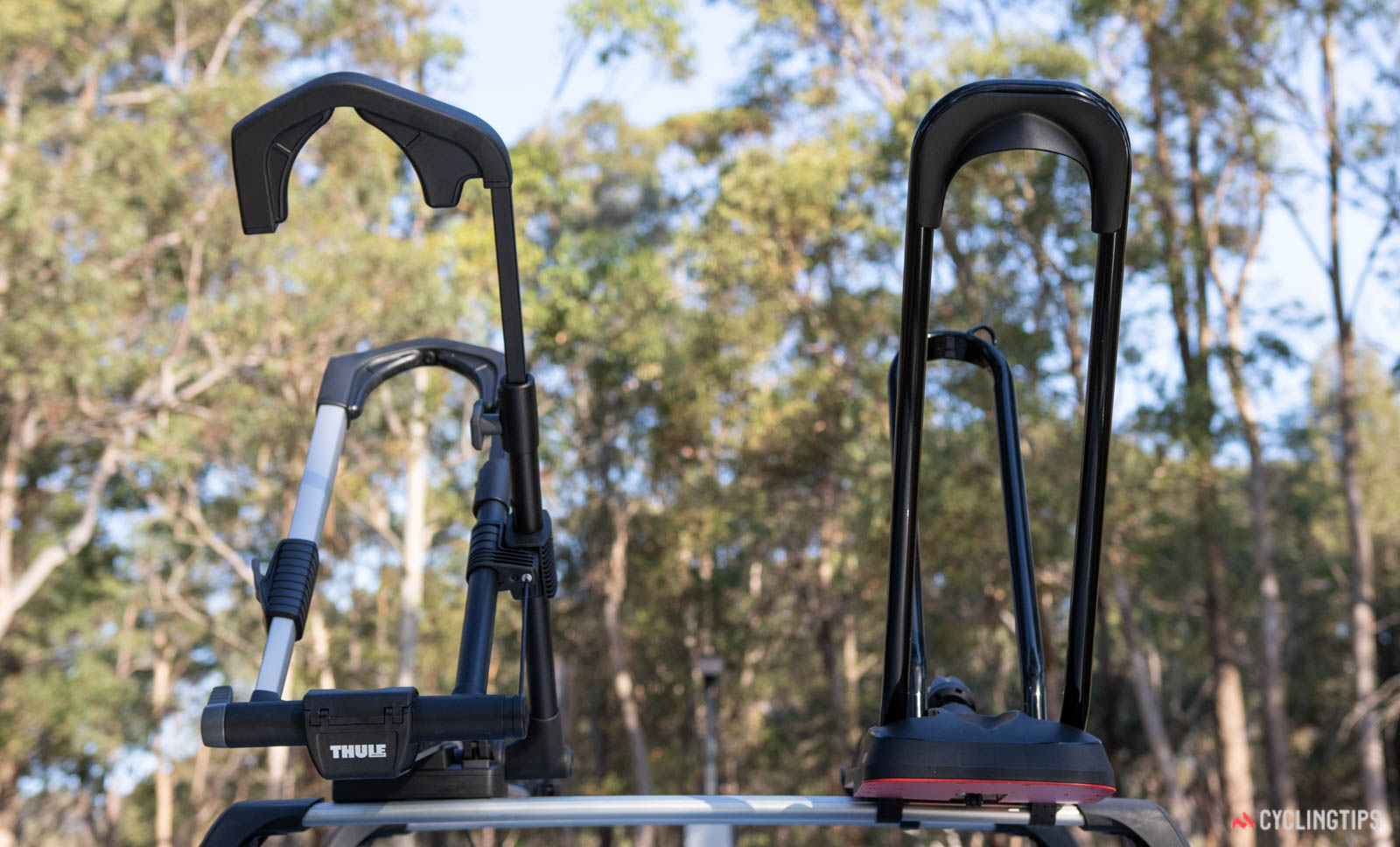 The Thule UpRide looks like a fancier piece of kit, but the Yakima HighRoad is easier to use, and that’ll be enough for most people.
The Thule UpRide looks like a fancier piece of kit, but the Yakima HighRoad is easier to use, and that’ll be enough for most people.Last updated: 27th September 2018